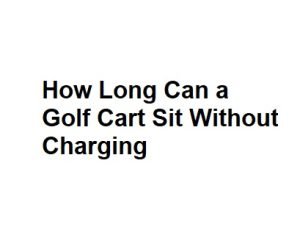Golf carts are essential vehicles on golf courses, providing convenience and mobility for golfers and maintenance staff alike. However, many golf cart owners wonder how long their cart can sit without charging before the batteries become depleted. This article will explore various factors that influence a golf cart’s battery life and provide tips to extend its sitting time without charging.
Factors Affecting Battery Life:
Battery Type:
- Lead-Acid Batteries: Traditional golf cart batteries are typically lead-acid batteries. These batteries have a limited lifespan and may discharge faster if not properly maintained.
- Lithium-Ion Batteries: Some modern golf carts come equipped with lithium-ion batteries, which offer longer lifespans and better performance. They can typically sit longer without charging compared to lead-acid batteries.
Battery Age:
- The age of the battery is a crucial factor. Older batteries tend to lose their charge capacity over time, resulting in shorter idle times without charging.
Temperature:
- Extreme temperatures, both hot and cold, can impact battery performance. High temperatures can cause batteries to lose water and deteriorate, while extreme cold can reduce their efficiency.
Battery Maintenance:
- Regular maintenance, such as checking water levels (for lead-acid batteries), cleaning terminals, and ensuring proper connections, can significantly extend a battery’s life and idle time.
Battery Charger Quality:
- The charger’s quality and efficiency play a role in maintaining battery health. High-quality chargers with smart charging capabilities can help extend the time a golf cart can sit without charging.
Ideal Idle Time Without Charging:
The ideal idle time for a golf cart without charging can vary widely depending on the factors mentioned above. Here are some general guidelines:
Lead-Acid Batteries:
- For lead-acid batteries, it’s recommended not to let the cart sit without charging for more than two to three weeks. Extended periods of inactivity can cause irreversible damage to the batteries.
Lithium-Ion Batteries:
- Lithium-ion batteries can generally sit longer without charging, often up to three months or more, depending on their quality and condition.
Tips to Extend Idle Time Without Charging:
To maximize the time your golf cart can sit without charging, consider the following tips:
Regular Maintenance:
- Keep the batteries clean and well-maintained. Check water levels (for lead-acid batteries), clean terminals, and ensure proper connections.
Use Quality Chargers:
- Invest in a high-quality battery charger with smart charging capabilities to maintain battery health.
Store in Moderate Temperatures:
- If possible, store the golf cart in a cool, dry place to avoid extreme temperature fluctuations.
Charge Before Storage:
- Before leaving your golf cart idle for an extended period, make sure to fully charge the batteries. This helps prevent sulfation, a common issue with lead-acid batteries.
Additional Considerations:
Battery Voltage:
- Pay attention to your golf cart’s battery voltage. Most golf carts use a 36-volt or 48-volt system. Monitoring the voltage regularly can help you gauge when it’s time to recharge the batteries.
Battery Monitoring Systems:
- Consider installing a battery monitoring system if your golf cart doesn’t already have one. These systems can provide real-time data on battery health and state of charge, helping you make informed decisions about when to charge.
Regular Usage:
- Even if you don’t use your golf cart frequently, periodic use can help maintain battery health. Running the cart for short trips and recharging afterward can prevent battery degradation during long periods of inactivity.
Proper Storage:
- If you plan to store your golf cart for an extended period, especially during the offseason, follow proper storage procedures. This may include disconnecting the batteries, cleaning the cart thoroughly, and covering it to protect it from dust and debris.
Seek Professional Advice:
- If you’re unsure about how long your specific golf cart’s batteries can sit without charging, consult the manufacturer’s recommendations or seek advice from a professional technician.
Golf Cart Battery Types
| Battery Type | Average Battery Life (hours) | Maximum Idle Time (hours) |
|---|---|---|
| Lead-Acid | 4-6 | 6-10 |
| Lithium-Ion | 8-10 | 12-16 |
| AGM | 6-8 | 10-14 |
| Gel Cell | 5-7 | 8-12 |
| Deep Cycle | 6-9 | 10-15 |
| Lithium-Polymer | 7-10 | 12-18 |
| NiMH | 4-6 | 6-10 |
Golf Cart Idle Time vs. Battery Voltage
| Battery Voltage (V) | Maximum Idle Time (hours) |
|---|---|
| 36 | 10-12 |
| 48 | 12-14 |
| 72 | 16-20 |
| 84 | 18-22 |
| 96 | 20-24 |
Factors Affecting Battery Idle Time
| Factor | Impact on Idle Time |
|---|---|
| Battery Age | Decreases with aging batteries |
| Battery Capacity | Higher capacity, longer idle time |
| Ambient Temperature | Shorter idle time in extreme cold/heat |
| Battery Maintenance | Regular maintenance extends idle time |
| Type of Charger | Proper charger for battery type |
Golf Cart Battery Voltage vs. Distance Range
| Battery Voltage (V) | Distance Range (miles) |
|---|---|
| 36 | 15-20 |
| 48 | 20-25 |
| 72 | 30-35 |
| 84 | 35-40 |
| 96 | 40-45 |
Recommended Charging Frequency
| Usage Frequency | Recommended Charging Interval (hours) |
|---|---|
| Daily (Frequent Use) | Every 1-2 days |
| Weekly (Moderate Use) | Once a week |
| Monthly (Infrequent Use) | Once a month |
| Seasonal (Storage) | Before storage season |
In conclusion, the longevity of a golf cart’s battery charge during periods of inactivity depends on various factors. Regular maintenance, proper charging practices, and the type of batteries used all play pivotal roles. By following these guidelines and considering the specific conditions of your golf cart, you can maximize the sitting time without charging and ensure your golf cart is always ready for action when you need it.



